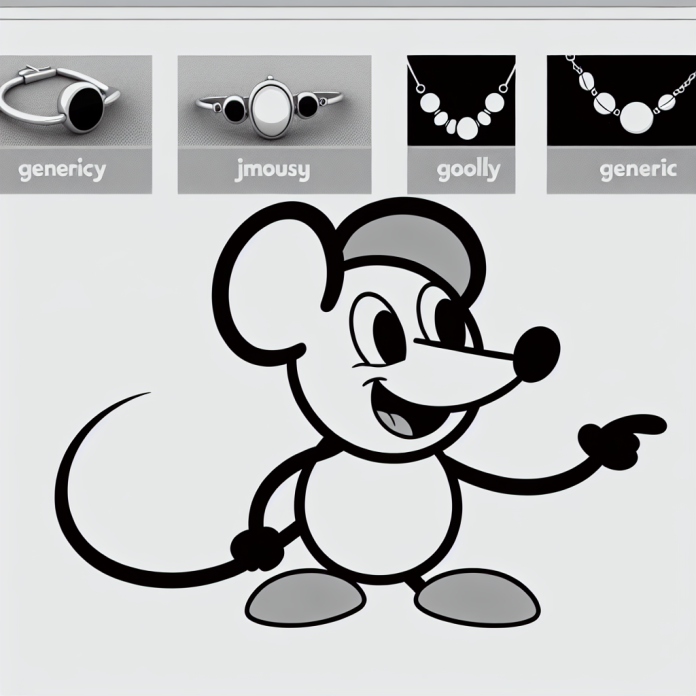The recent Mickey Mouse jewelry lawsuit highlights The Walt Disney Company’s commitment to safeguarding its renowned trademarks. Filed in federal court in Los Angeles, the lawsuit targets a Hong Kong jewelry company known as Red Earth Group, which markets products under the name Satéur. Disney alleges that the company’s “Mickey 1928 Collection” infringes on its trademark rights, misleading customers into thinking they are purchasing authentic Mickey Mouse merchandise. By claiming the iconic character as their own brand identifier, Satéur is allegedly profiting from Disney’s intellectual property and the longstanding affection consumers have for Mickey Mouse. This litigation underscores the critical importance of protecting Mickey Mouse merchandise rights in an era where trademark infringement can easily create consumer confusion.
In a striking legal maneuver, Disney has positioned itself against a Hong Kong-based jewelry enterprise, known for its Satéur brand, due to allegations of trademark infringement involving Mickey Mouse. The lawsuit serves as a pivotal reminder of the company’s vigilant stance on its intellectual property rights, particularly regarding beloved characters like Mickey Mouse. By referencing both the iconic character’s historical significance and current market practices, Disney reinforces its claims against Satéur’s jewelry offerings. The legal battle emphasizes the essential nature of protecting brand identity in the competitive marketplace. As this case unfolds, it highlights the ongoing struggles surrounding the ownership rights of popular cultural symbols.
The Legal Battle Over Mickey Mouse Jewelry
The Walt Disney Company recently initiated legal proceedings against the Red Earth Group, a Hong Kong jewelry company, for allegedly selling unauthorized Mickey Mouse jewelry. This lawsuit underscores the ongoing battle over Disney’s trademark rights, particularly as it relates to the iconic character of Mickey Mouse, which has significant recognition and emotional connection among fans. By filing the suit in federal court in Los Angeles, Disney aims to send a strong message about its commitment to protecting its intellectual property from infringement and misuse.
Disney’s lawsuit specifically targets the “Satéur Mickey 1928 Collection”, which includes rings, necklaces, and earrings that feature Mickey Mouse designs. These products allegedly mislead consumers into thinking they are official merchandise. Disney asserts that such marketing practices not only violate its trademark rights but also dilute the value of the Mickey Mouse brand. The company argues that any unauthorized adaptation of its character threatens consumers’ trust and the integrity of its established merchandise rights.
Trademark Infringement and Consumer Confusion
In the realm of intellectual property, trademark infringement occurs when one party uses a trademark that is identical or confusingly similar to another party’s registered trademark without authorization. This case exemplifies the critical nature of protecting brand identity, as Disney argues that the character of Mickey Mouse is a key component of its merchandise rights. The lawsuit claims that Satéur’s description of its items as being ideal for ‘Disney enthusiasts’ is a deliberate attempt to confuse consumers regarding the origin of the jewelry, which is not officially associated with Disney.
The act of misrepresenting products can lead to significant ramifications both for consumers and the rightful trademark owner. Disney aims to eliminate such consumer confusion by seeking an injunction against Satéur, which, if granted, would legally prevent the Hong Kong company from selling products infringing on Disney’s trademark rights. This case not only highlights the importance of intellectual property protection but also illustrates how companies must navigate the fine line between inspiration and imitation in their product offerings.
Impact of Disney’s Intellectual Property Policies
Disney’s proactive stance on enforcing its intellectual property rights demonstrates the company’s commitment to maintaining its brand integrity against potential dilution. The enforcement of trademark rights is crucial in industries where brand loyalty is essential for sales, such as jewelry. With products like the ‘Satéur Mickey 1928 Classique Ring,’ which contains elements that evoke Disney’s rich heritage, these unauthorized pieces can mislead customers and undermine the value of official Disney merchandise.
Through this lawsuit, Disney asserts that it will not tolerate misuse of its trademarks, and it seeks to uphold consumer confidence in its authenticity. The company’s protection of its Mickey Mouse merchandise rights serves as a reminder to other businesses about the importance of respecting intellectual property. Avoiding legal disputes and fostering a genuine connection with consumers through original designs not only protects brands but also enhances the overall value of their offerings.
The Role of Trademark Rights in Creative Industries
Trademark rights play a vital role in the creative industries by safeguarding the distinctiveness of brands within competitive markets. In this case involving the ‘Satéur Mickey 1928 Collection’, Disney defends its trademark against what it perceives as infringement that could confuse consumers. Protecting these rights is not just about mitigating financial loss; it is also about preserving the cultural significance that characters like Mickey Mouse hold for audiences worldwide.
Creative industries thrive on innovation, yet the respect for established trademarks fosters a fair market. Disney’s lawsuit reinforces the message that while homage to beloved characters may inspire creativity, any profit derived from such inspirations must still comply with trademark law. This legal action is not only a defense of Disney’s assets but also a call for ethical business practices within creative sectors.
Consumer Awareness Amid Trademark Infringement
As the Disney lawsuit unfolds, consumer awareness around trademark infringement becomes increasingly relevant. Many customers may unwittingly purchase products believing them to be official merchandise when, in fact, they are the result of unauthorized use of trademarked characters. In light of this, Disney’s efforts to protect its intellectual property strive to educate the public regarding the distinctions between authentic products and those of dubious origin.
By emphasizing the significance of recognizing trademark symbols and official branding, Disney aims to empower consumers to make informed purchasing decisions. This case serves as a pivotal point for promoting legal compliance in merchandise production, reinforcing the importance of supporting original creations and holding companies accountable for ethical practices in marketing. The outcome could set a precedent for future cases regarding Disney’s trademarks and its continued dominance in protecting its brand.
Legal Repercussions for Unauthorized Merchandise
The implications of the Disney lawsuit against Red Earth Group extend beyond just financial reparations; they may serve as a warning to other companies engaging in similar practices. Unauthorized merchandise, especially those associated with globally recognized characters such as Mickey Mouse, can lead to severe legal repercussions, including injunctions against the sale of infringing items and significant monetary damages.
For Disney, the stakes are high, as the brand’s identity is intertwined with its characters, which are both assets and cultural icons. This lawsuit could deter future infringement by making it clear that the company is vigilant in protecting its intellectual property rights. Companies must recognize that while creating inspired pieces is part of innovation, they must tread carefully to avoid overstepping legal boundaries.
The Importance of Authentic Disney Merchandise
As Disney navigates the current legal landscape regarding the unauthorized use of Mickey Mouse, the importance of selling authentic Disney merchandise becomes more pronounced. Authentic products not only guarantee quality and craftsmanship but also support the creative teams behind the designs and narratives that make Disney products beloved worldwide. Consumers are encouraged to seek out official merchandise to ensure they are investing in genuine pieces that respect the brand’s legacy.
Moreover, purchasing authentic merchandise supports a broader economic ecosystem that includes creators, designers, and retailers who contribute to the Disney brand. By valuing official products, consumers also assert their appreciation for creativity and artistry, fostering an environment where originality is celebrated rather than diluted. This reinforces Disney’s mission to deliver exceptional experiences and quality through its merchandise.
Trademark Enforcement: Lessons from Disney’s Case
Disney’s legal actions, particularly involving the dispute with Red Earth Group, impart important lessons for businesses regarding trademark enforcement. Companies must be vigilant in monitoring their trademarks and ready to enforce their rights, as neglecting them may result in a loss of brand identity and consumer trust. The case highlights the necessity of maintaining an active presence in protecting intellectual property, as companies like Disney represent invaluable assets that require safeguarding.
Additionally, establishing clear branding guidelines and maintaining a consistent message across merchandise can help mitigate risks associated with infringement. By understanding the legal frameworks surrounding trademarks, businesses can navigate creative expression while respecting others’ rights. Disney’s steadfast approach illustrates that protecting a brand is not only about preserving revenue but also about honoring the emotional connections that consumers have with their favorite characters.
Future Implications for Disney and Other Brands
The outcome of Disney’s lawsuit against the Hong Kong jewelry company could have significant implications not only for Disney but also for other brands facing similar challenges. A ruling in favor of Disney could reinforce strict adherence to trademark laws and encourage businesses to develop original products that do not infringe upon established brands. This is particularly vital in markets flooded with knockoffs that jeopardize consumers’ trust.
On a broader scale, the case may initiate a trend of increased legal scrutiny over trademark use in various industries, setting a precedent that emphasizes the sanctity of intellectual property rights. As the digital marketplace expands and more brands proliferate online, vigilance in protecting trademarks will be crucial for new and established companies alike, shaping a future where the value of authenticity is celebrated more than ever.
Frequently Asked Questions
What is the Mickey Mouse jewelry lawsuit filed by Disney?
The Mickey Mouse jewelry lawsuit involves The Walt Disney Co. suing a Hong Kong jewelry company, Red Earth Group, for allegedly selling illegal Mickey Mouse jewelry. Disney claims the company’s ‘Mickey 1928 Collection’ violates its trademark rights by misleading customers into thinking these pieces are official Disney merchandise.
Why did Disney sue the Hong Kong company for selling Mickey Mouse jewelry?
Disney’s lawsuit against the Hong Kong company is based on trademark infringement. The company, which sells jewelry under the name Satéur, is accused of using Mickey Mouse as a brand identifier, thereby profiting from Disney’s intellectual property and causing confusion among consumers.
What are the specific items involved in the Mickey Mouse jewelry lawsuit?
The lawsuit specifically mentions items such as rings, necklaces, and earrings from Satéur’s ‘Mickey 1928 Collection.’ Notably, the ‘Satéur Mickey 1928 Classique Ring’ features a Steamboat Willie charm, which Disney argues is an unauthorized use of its character.
How does the Mickey Mouse jewelry lawsuit impact Disney’s intellectual property rights?
The Mickey Mouse jewelry lawsuit emphasizes Disney’s commitment to protecting its intellectual property rights. Disney argues that while the original version of Mickey Mouse has entered the public domain, its trademark rights still apply, and unauthorized uses can lead to consumer confusion, which the company aims to prevent.
What actions is Disney seeking through the Mickey Mouse jewelry lawsuit?
In the Mickey Mouse jewelry lawsuit, Disney is seeking an injunction to stop Red Earth Group from selling the unauthorized Mickey Mouse jewelry. Additionally, Disney is pursuing monetary damages as a result of the alleged trademark infringement.
How does this lawsuit relate to Mickey Mouse merchandise rights?
This lawsuit directly pertains to Mickey Mouse merchandise rights, as it seeks to uphold Disney’s trademarks against unauthorized use. Disney asserts that Red Earth Group’s use of Mickey Mouse in its jewelry collection infringes upon those rights, potentially misleading consumers and harming the Disney brand.
What claims does Disney make about Satéur’s marketing practices?
Disney alleges that Satéur’s marketing practices, which promote the jewelry as perfect for ‘Disney enthusiasts,’ are intentionally misleading and aim to confuse consumers regarding the authenticity of the Mickey Mouse jewelry, thereby infringing on Disney’s trademark rights.
| Key Points | Details |
|---|---|
| Lawsuit Filed | Disney is suing Hong Kong’s Red Earth Group for selling illegal Mickey Mouse jewelry. |
| Court | The lawsuit was filed in federal court in Los Angeles. |
| Trademark Violation | Disney claims that the ‘Mickey 1928 Collection’ violates its trademark rights. |
| Marketing Misleading | The company markets its products as official Disney merchandise, misleading customers. |
| Public Domain vs. Trademark | Although Mickey Mouse has entered public domain, trademark rights protect against unauthorized use. |
| Consumer Confusion | Disney alleges intentional marketing to confuse consumers, promoting the jewelry for ‘Disney enthusiasts’. |
| Injunction and Damages | Disney seeks an injunction against sales and is pursuing monetary damages. |
| Commitment to IP | Disney is committed to protecting its intellectual property and brand identity. |
Summary
The Mickey Mouse jewelry lawsuit highlights Disney’s ongoing efforts to protect its intellectual property rights against unauthorized use by third parties. This case exemplifies how companies must navigate trademark laws, even as some characters enter the public domain. By taking legal action against the Red Earth Group, Disney is not only defending its brand identity but also ensuring that consumers are not misled by counterfeit products. The outcome of this lawsuit could have significant implications for the future of trademark protections in the entertainment industry.
Source: https://www.ocregister.com/2025/07/16/disney-sues-mickey-mouse-jewelry/
### Transform Your Home: The Ultimate Guide to OC Remodeling
Home renovations in Orange County are more than just aesthetic upgrades; they’re a smart investment given the region’s booming real estate market, where the median home value stands at approximately $1.18 million. Homeowners in affluent areas such as Laguna Beach and Newport Beach often seek high-quality, durable renovations to enhance their properties’ value and appeal. As a contractor or remodeler, understanding this market can lead to substantial business opportunities. With many homeowners willing to invest between $50,000 and $500,000 in renovations, the demand for skilled OC contractors is at an all-time high, particularly for kitchens, bathrooms, and outdoor living spaces.
### Navigating Local Building Codes and Climate Considerations
When embarking on a remodeling project in Orange County, it’s crucial to be aware of the specific California building codes and permit requirements. Whether you’re tackling a project in Irvine or Costa Mesa, local regulations can dictate everything from structural integrity to energy efficiency standards. Additionally, OC’s unique climate calls for materials and design choices that withstand coastal weather, particularly in cities like Huntington Beach. Contractors should familiarize themselves with local suppliers who provide high-quality materials compliant with these regulations and suited for the OC climate. This knowledge not only streamlines your projects but also builds trust with clients.
### Seizing Opportunities in the OC Remodeling Market
As you navigate through your projects in this vibrant market, look for unique offerings that cater to the luxury segment of Orange County’s homeowners. Eco-friendly renovations, smart home technologies, and custom outdoor living spaces are highly sought after. By leveraging local relationships, such as partnerships with landscape architects and eco-friendly material suppliers, contractors can enhance their service offerings. Showcasing successful remodeling projects on social media platforms that target OC residents can spark interest and generate leads. Remember, engaging content that highlights your expertise and the beauty of transformed homes can inspire potential clients to take the next step.
### Call to Action: Engage with the OC Community
In the competitive landscape of Orange County home renovations, building a network with other professionals and engaging with the local community is essential. Consider attending local home expos or joining OC homeowner groups to showcase your work and meet potential clients. By establishing your brand as a trusted remodeling expert in cities like Costa Mesa and Newport Beach, you can foster invaluable relationships that lead to increased referrals and repeat business. Don’t let the opportunity slip by to be part of this thriving market—connect with local homeowners today and start transforming spaces!


